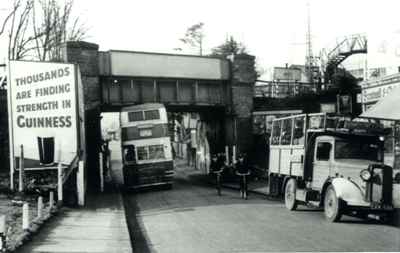 Worcester Park 2008 Worcester Park 2008
Route 127
Route 127 was the first in London's red bus area to operate
low-height double-deck buses (and one of only four that ever needed
them), as well as being the first such route to be withdrawn.
Running virtually a circle from Morden to South
Wimbledon via North
Cheam and New Malden, it was the 13' 6" clearance of the
railway bridge at Worcester Park Station
that gave rise to the use of special buses. The running day
marks 50 years since the route was withdrawn.
Manchester Corporation no.
192, a 1930 Crossley with a 1935 Crossley body, passes under
Worcester Park bridge with precious
little room to spare. Photo Charles Klapper ©
Omnibus Society, Alan Cross collection
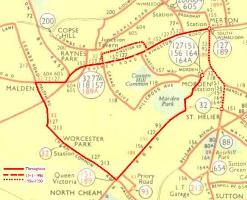 Original route MORDEN to SOUTH WIMBLEDON via Worcester Park (1941
to 1956)
MORDEN to ST HELIER via Worcester Park, Raynes
Park and South Wimbledon (1956 to 1958)
Timetable
The 127 will operate between Morden and Malden
via Worcester Park every 20 minutes, with hourly journeys
extended to St Helier. Timetable attached. Note that most
buses will pause for a few minutes at Worcester Park.
Main boarding points
Click on the map to
enlarge
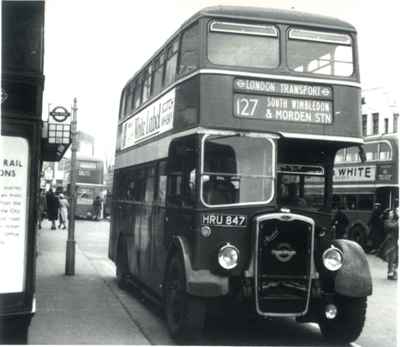 Brief
history Originally introduced (as the 155) when the tube reached
Morden in 1926, the route was renumbered 245 in 1934, then 127
in 1941 when converted from single-deck to low-height
double-deck. The route ran from Morden to South
Wimbledon until October 1956, when it was extended to St Helier,
covering for the withdrawal of the 32. The route fell victim
to the cuts in service that followed the long bus strike of 1958,
an event which may be considered to mark the beginning of the
downturn in fortunes of London Transport bus services for the rest
of the 20th century, and was withdrawn in August 1958.
As London Transport initially had no available low-height
buses, the route was converted using buses loaned by Manchester
Corporation, later replaced by buses brought from LT's Country
Area. A variety of buses, including a batch of specially
purchased utility Daimlers, was operated until the post-war
RLHs were introduced in 1951. A detailed history of that
class is given on the RLH Information Centre
site.
Loaned Hants & Dorset Bristol K HRU847 at
Morden on 7 Feb 50
 Detailed route history Back in 1926, the tube network was growing. The
Northern Line reached Morden that September and a series of
bus services were introduced to link Morden with the developing
suburban area to the south. Presumably in anticipation, three
new bus routes started in July 1926, linking Wimbledon (the
then southernmost Underground station) with Morden and the
suburbs beyond.
These routes were the 155 via North Cheam to Worcester Park,
the 156 via North Cheam to Cheam and the 164 via North Cheam
and Ewell to Burgh Heath. These three were shortened to
run from Morden Station when it opened, and were then joined by the
157 via Rose Hill and Sutton to
Wallington and the 165 via Rose Hill and Sutton to Banstead.
All were introduced with K-class single-deckers from Sutton
garage. Increasing traffic led to the double-decking of the
156, 157 and 165 in 1927 and 164 in 1928, but the 155 remained
single-deck due to the low bridge at Worcester Park station.
S433, now the sole
preserved example of a 1923 S-type, seen at Morden Station in
1930 about to set off for South Wimbledon Station on the
155B.
Photo W Noel Jackson
collection, © Alan Cross
 The
155 was briefly extended north and westwards to South Wimbledon and
Raynes Park from January 1927. The Raynes Park section was
transferred to the 165 in August 1928, when the 155 instead was
extended to form a circle from Worcester Park via Kingston Bypass
and South Wimbledon back to Morden. At the same time, short
workings between Morden and South Wimbledon (the long way round!)
were introduced, numbered 155 B under the Bassom system.
ST162 was one of the National Services
lowbridge STs, built for the Watford-Chesham route (later
336). They had twin gangways upstairs, with 3-in-a-row bench
seats (more details from Ian Smith here).
It was amongst the green buses to operate the 127 and is seen late
in its life opposite the Woodstock on 27 Jun 51. Photo © Alan Cross
The route was then transferred to Merton garage, using S-class
single-deckers. Two years later, the main route was withdrawn
and all workings ran to South Wimbledon as the
155 B; in 1931 operation returned to Sutton
garage. The route was supplemented from 1932 on
weekday peaks by double-deck short workings from Malden to South
Wimbledon, using NSs and numbered 155 C. Meanwhile,
Sutton introduced single-deck LT Scooters to replace the Ss for 6
months from August 1932 and permanently from February 1934.
From October 1934, the new route
numbering scheme was adopted that abolished suffixes for short
workings and segregated single-deck routes into the
200-series. Accordingly, the 155 B and
155 C were renumbered as the 245 (even thought the Malden
shorts were double-deck NS-operated until replaced by extras on the
152 in March 1936). The 245 was rerouted beyond the Kingston
Bypass to serve New Malden Fountain from October
1936.
Typical of the second
batch of lowbridge Daimlers is D128 heading for Morden in Worcester
Park in 1948.
Photo © Alan Cross
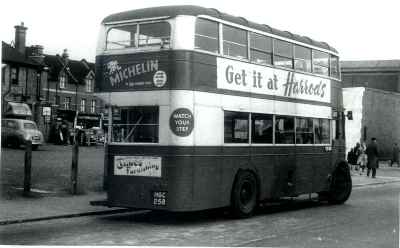 For economic reasons, it was London Transport policy to
operate double-deck buses on all urban routes unless this was not
physically possible. For a period after 1934, single-deck
routes that were converted to double-deck were renumbered into the
1-199 sequence. This practice came to an end in 1941,
presumably because wartime conditions meant the resources involved
in the practice (which must have seemed bizarre to the travelling
public) could not be justified. However, three routes were
double-decked and renumbered that year, including the 245 on 22
January to meet the capacity requirements of the factories in
the Malden area. Since December 1939, however, the route had
not run evenings or Sundays.
Throughout the short lives
of the utility Daimlers, the route terminated at South Wimbledon,
where they turned and stood in Milner Road. D131 is seen here
on 27 Oct 52, shortly before the arrival of the RLHs and the
despatch of the Daimlers.
Photo © Alan Cross
The low bridge at Worcester Park mean that normal
double-deckers could not be used. The 127 was thus the first
Central Area route to use low-height double-deckers, and there were
none in the fleet, wartime needs overruling the dislike by the
police of their operation. The change was made possible by
the availability of loaned Manchester Corporation Crossleys and
Leyland Titans, although these buses were no available for very
long. In August, 5 STs from LT's Country Area were drafted
in, made available from Watford by the splitting of the 410 at
Biggin Hill and the resulting ability to run normal height
buses on the northern section, in turn allowing Godstone
STLs to be transferred to Watford. However, this provided
only half the allocation and single-deckers continued to help out,
first LTs, then Qs. Within two months of the arrival of the
STs, the allocation moved back from Sutton to Merton garage.
Merton continued to
provide occasional single-deckers on the 127 until the RLHs
arrived.
Here Q160 shows why the
route needed double-deckers - South Wimbledon, 22 Sep 50.
In 1942, LT were permitted to build some new lowbridge
STL bodies, which were fitted onto existing chassis.
These became available in September and the route was
fully converted to double-deck. No more new buses were
available until the arrival of a specially-built batch of six
utility-bodied Daimlers in April and May 1944, which relaeased the
STs and worked alongside the STLs until the arrival of the second
batch of four in November 1945. Whilst the Ds
formed the official allocation until the advent of the red
RLHs in December 1952, other buses continued to appear from time to
time. Meanwhile, Sunday operation reappeared during 1947 only
to vanish later in the year.
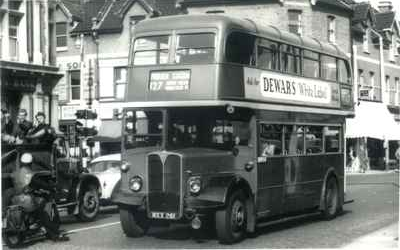 Ten RLHs arrived at Merton in December 1952 and the route
settled down to a period of stability until local changes on 17 Oct
56 led to the withdrawal of the 32. The 32 ran from St Helier
to Worcester Park, following the route of the 127 except that it
served Raynes Park Station. It was replaced by
extension of the 127 to St Helier and its diversion away
from Bushey Road to serve Raynes Park Station.
So far so good, but in 1958 London's busmen went on strike for
about six weeks, causing a massive loss of traffic as the
travelling public discovered alternatives to the bus (such as the
private car) and as a result a substantial reduction in bus
mileage. The 127 was one of the routes withdrawn without
replacement.
Later to be the last RLH in service on the
178, and later still to be brought back from the USA and restored
by Ensign, RLH61 is seen here after the strike on 19 Aug 58.
Photo © Alan Cross
There were four RLH routes in the Central Area. The
230,
which had been converted from single-deck to lowbridge
STL (but not renumbered) in 1942, was the first in
November/December 1952, followed by the 127. The
248
was converted from single-deck in February 1955 and the 178, created from the 208A using buses withdrawn from the
127, in 1959. The other three were all in turn replaced
by single-deck routes, the 127 being the only one to be withdrawn
completely.
|